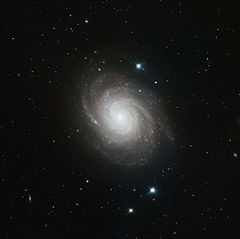NGC 4030
 Galaktyka NGC 4030 (ESO) | |
| Odkrywca | |
|---|---|
| Data odkrycia | 1 stycznia 1786 |
| Dane obserwacyjne (J2000) | |
| Gwiazdozbiór | |
| Typ | spiralna (Sbc) |
| Rektascensja | 12h 00m 23,4s |
| Deklinacja | –01° 06′ 02″ |
| Przesunięcie ku czerwieni | 0,004906[1] |
| Jasność obserwowana | 10,6m |
| Rozmiary kątowe | 4,2' × 3,2' |
| Alternatywne oznaczenia | |
| UGC 6993, MCG 0-31-16, ZWG 13.33, IRAS11578-0049, PGC 37845 | |
NGC 4030 (również PGC 37845 lub UGC 6993) – galaktyka spiralna (Sbc), znajdująca się w gwiazdozbiorze Panny. Została odkryta 1 stycznia 1786 roku przez Williama Herschela[2].
W galaktyce tej zaobserwowano supernową SN 2007aa[3].
Zobacz też
Przypisy
Linki zewnętrzne
- NGC 4030 w serwisie SEDS.org (Revised NGC and IC Catalog) (ang.)
- NGC 4030 w bazie SIMBAD (ang.)
- NGC 4030 w NASA/IPAC Extragalactic Database (ang.)
Media użyte na tej stronie
Autor: ESO/P. Grosbøl, Licencja: CC BY 4.0
This spiral galaxy, NGC 4030, lies about 75 million light-years from Earth, in the constellation of Virgo. In 2007 Takao Doi, a Japanese astronaut who doubles as an amateur astronomer, spotted a supernova — a stellar explosion that is briefly almost as bright as its host galaxy — going off in this galaxy. The image was made in infrared light with the HAWK-I camera on ESO’s Very Large Telescope at Paranal Observatory in Chile. HAWK-I is one of the most powerful infrared imagers in the world, and this is one of the sharpest and most detailed pictures of this galaxy ever taken from Earth. The filters used were Y (shown here in blue), J (in green), H (in orange), and K (in red). The field of view of the image is about 6.4 arcminutes across.
